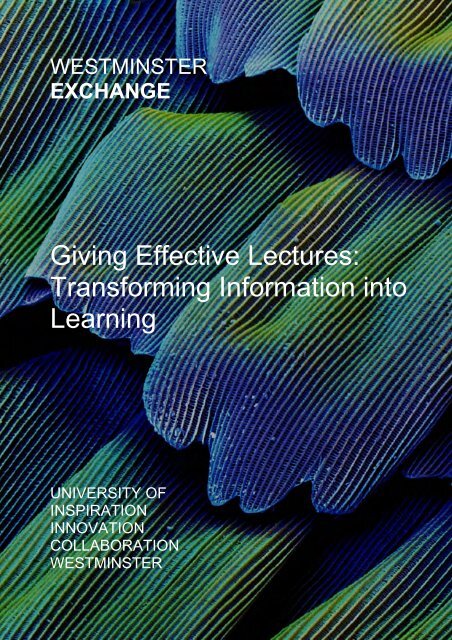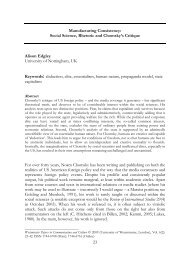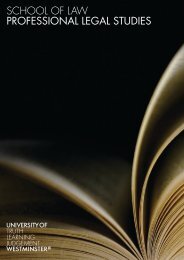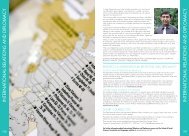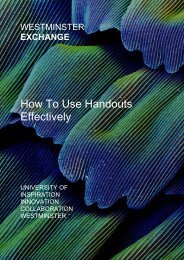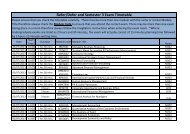Giving Effective Lectures - University of Westminster
Giving Effective Lectures - University of Westminster
Giving Effective Lectures - University of Westminster
You also want an ePaper? Increase the reach of your titles
YUMPU automatically turns print PDFs into web optimized ePapers that Google loves.
WESTMINSTER<br />
EXCHANGE<br />
<strong>Giving</strong> <strong>Effective</strong> <strong>Lectures</strong>:<br />
Transforming Information into<br />
Learning<br />
UNIVERSITY OF<br />
INSPIRATION<br />
INNOVATION<br />
COLLABORATION<br />
WESTMINSTER
The copyright in this work is vested in <strong>University</strong> <strong>of</strong> <strong>Westminster</strong> and the document is<br />
issued in confidence only for the purpose for which it is supplied. It must not be reproduced<br />
in whole or in part or used for tendering or manufacturing purposes except under an<br />
agreement or with the consent in writing <strong>of</strong> the <strong>University</strong> <strong>of</strong> <strong>Westminster</strong> and then only on<br />
condition that this notice is included in any such reproduction. No information as to the<br />
contents or subject matter <strong>of</strong> this document or any part there<strong>of</strong> arising directly or indirectly<br />
there from shall be given orally or in writing or communicated by any means whatsoever to<br />
any third party being an individual firm or company or any employee there<strong>of</strong> without the<br />
consent in writing <strong>of</strong> the <strong>University</strong> <strong>of</strong> <strong>Westminster</strong>.<br />
© <strong>Westminster</strong> Exchange, <strong>University</strong> <strong>of</strong> <strong>Westminster</strong> (2009)<br />
2
1. What is the purpose <strong>of</strong> lectures................................................................................... 4<br />
2. What are the potential problems with lectures ............................................................ 4<br />
3. Build in activities to transform information into learning ................................................ 5<br />
4. Have a clear structure................................................................................................... 6<br />
5. Building changes <strong>of</strong> activity into lectures ...................................................................... 6<br />
6. Making lectures more student-centred.......................................................................... 7<br />
7. Making lectures more personal..................................................................................... 8<br />
8. Encouraging students to ask and answer questions in large groups ............................ 8<br />
9. Dealing with latecomers and disruptive behaviour........................................................ 9<br />
10. Use <strong>of</strong> Audio Visual Aids (AVAs)............................................................................. 10<br />
11. Presentation Skills................................................................................................... 10<br />
12. Conclusion .............................................................................................................. 11<br />
13. Useful references .................................................................................................... 11<br />
WEx Guides: ...................................................................................................................... 11<br />
Appendix 1 ......................................................................................................................... 12<br />
Author: Ann Rumpus<br />
Version: 1.4<br />
3
1. What is the purpose <strong>of</strong> lectures<br />
There may be a number <strong>of</strong> reasons for using lectures in <strong>University</strong> education which<br />
include:<br />
• providing a framework on which students can build by further reading;<br />
• engaging the students’ interest in the topic;<br />
• summarising information from a range <strong>of</strong> sources;<br />
• updating students with cutting edge research developments, or current issues,<br />
which may not yet have entered the academic literature;<br />
• providing the students with the expert’s perspective and/or enthusiasm;<br />
• an opportunity for the lecturer to model certain reasoning processes;<br />
• providing a shared learning experience for students and staff.<br />
All the above can be advantageous and effective ways <strong>of</strong> stimulating students into further<br />
work and learning, and these can be met appropriately through lectures. However, it is also<br />
frequently the case that lectures are used as a way <strong>of</strong> relaying information to students, and<br />
one which is deemed cost effective for large numbers <strong>of</strong> students. We must remember that<br />
information on its own does not guarantee learning; students must go through a process <strong>of</strong><br />
interacting with information to convert it to knowledge.<br />
Additionally some students (particularly in their first year) will have a poor understanding <strong>of</strong><br />
the purpose <strong>of</strong> the lecture and the learning they should draw from it. There are a number <strong>of</strong><br />
actions which we can take to increase the extent to which students engage with material in<br />
lectures and we should try to deploy these. Otherwise a formal lecture might be no better<br />
at engendering learning than other forms <strong>of</strong> teaching, and in terms <strong>of</strong> developing skills <strong>of</strong><br />
reasoning, analysis, presenting argument etc, it may be rather worse.<br />
2. What are the potential problems with lectures<br />
The risks that we run with lectures are outlined below. These issues are then debated in<br />
more detail through the rest <strong>of</strong> the document.<br />
1. There might be an overload <strong>of</strong> information presented in a lecture, but this does not<br />
ensure student learning.<br />
Ensure you give students an understanding <strong>of</strong> the purpose <strong>of</strong> the lecture. Give them<br />
activities which help transform the information into learning and knowledge.<br />
2. Students may easily become confused and lose the thread <strong>of</strong> a lecture unless it is<br />
clearly structured, and related to the learning outcomes.<br />
<strong>Lectures</strong> must be carefully planned and structured.<br />
3. Research (Biggs, 2003) has shown that students lose concentration within 15 – 20<br />
minutes, and will learn very little if they continue to sit and take notes with no<br />
change <strong>of</strong> activity.<br />
This impact can be decreased by building in some changes <strong>of</strong> activity.<br />
4. The students may become very passive, particularly if they are given little<br />
opportunity to participate and if they are also presented with a lot <strong>of</strong> the material as<br />
notes or handouts.<br />
This impact can be lessened by building in some changes <strong>of</strong> activity in which<br />
students are asked to interact with the materials which they have been given; by<br />
guiding them to take notes; by providing handouts with gaps which the students<br />
must actively fill.<br />
4
5. The lecture may become focussed on issues relating to the lecturer’s skills at<br />
presentation, rather than on the students’ learning.<br />
<strong>Lectures</strong> should be aimed at being as student-centred as possible.<br />
6. The lecture may be large and the students may find it an impersonal and alienating<br />
situation.<br />
Try to make the lecture as personal as possible.<br />
7. Students may be afraid <strong>of</strong> asking questions in front <strong>of</strong> a large group <strong>of</strong> students, and<br />
important misunderstandings or uncertainties may remain unaddressed.<br />
Have strategies to encourage students to ask questions, particularly in large lecture<br />
groups; ensure that students are given an opportunity to speak out in the first few<br />
minutes <strong>of</strong> the lecture so that they do not sink into a passive state.<br />
8. In a large lecture some <strong>of</strong> the students may behave poorly by talking, using mobile<br />
phones etc.<br />
Address behavioural issues in lectures, and recognise that the problems may arise<br />
because the students do not understand the purpose <strong>of</strong> the lecture.<br />
9. Latecomers can be very disruptive.<br />
Have a consistent way <strong>of</strong> dealing with this issue.<br />
10. Sometimes you are asked to present a lecture at short notice, by using another<br />
academic colleague’s notes and slides. This is always very difficult and generally<br />
the lecturer comes across as lacking in confidence and feels under-prepared.<br />
Always prepare your own notes and materials, even if you find it helpful to build on a<br />
colleague’s notes.<br />
11. Lecturers may misuse audio-visual aids (AVA), or find that they are not working, and<br />
hence disrupt the students’ learning.<br />
Apply careful thought to the choice <strong>of</strong>, and use <strong>of</strong>, AVA; include a back up plan in<br />
case they are not functioning.<br />
12. Lecturers may have poor presentation skills. Although these are only part <strong>of</strong> the<br />
lecturing process, it can be unhelpful if the students are unable to hear, or if the<br />
lecturer seems disengaged.<br />
Practice presentation skills and gain feedback.<br />
3. Build in activities to transform information into learning<br />
It is important to bear in mind that teaching is an integrated process and not a series <strong>of</strong><br />
piecemeal activities. A lecture is only part <strong>of</strong> the process and must be carefully aligned with<br />
other aspects <strong>of</strong> the module (e.g. seminars, practicals, assessment tasks etc.). It is<br />
important to ensure that the lecture has a purpose which you have clearly explained to the<br />
students, along with the links between the lectures and the other learning activities, and the<br />
learning outcomes <strong>of</strong> the module. Make sure that the lecture relates to the tasks which they<br />
will go away and undertake, perhaps in a subsequent tutorial/seminar session, through<br />
group work or by independent study. Rather than just providing information you can use<br />
the lecture to model your reasoning processes as an expert, or you could compare two<br />
contrasting views <strong>of</strong> a topic, or pose a series <strong>of</strong> questions which the students could follow<br />
up later.<br />
You can relate the material to work they have undertaken before, in the same or different<br />
modules, and to assessment tasks which they are undertaking. The students need to<br />
understand that learning is more than absorbing information encapsulated in the handouts,<br />
but it is part <strong>of</strong> an active process, and that engaging in the process fully will improve their<br />
performance over all. It might be useful to discuss with the student what their concept <strong>of</strong> a<br />
5
lecture is, and to emphasise the way you have designed it to enable them to engage with<br />
the material. Students need to be encouraged to process the material and hence transform<br />
it into learning. This processing might also be encouraged by activities which are built into<br />
the lectures which ask the students to think about the material, analyse aspects <strong>of</strong> it,<br />
disagree with certain concepts, discuss ideas in pairs and/or relate the input to other<br />
components <strong>of</strong> the module. This can be called a “sliced up lecture” consisting <strong>of</strong> balance <strong>of</strong><br />
input from the lecturer with student-based activities; this should also be built on with follow<br />
up activities after the lecture.<br />
4. Have a clear structure<br />
• <strong>Lectures</strong>, as much as any other teaching session, should be planned. Use a session<br />
plan to help you, appendix 1.<br />
• Be clear to yourself and the student about the relationship <strong>of</strong> the lecture to the rest<br />
<strong>of</strong> the module.<br />
• Be aware <strong>of</strong> the students’ prior knowledge and understanding <strong>of</strong> the topic, and <strong>of</strong><br />
the diversity in your students in terms <strong>of</strong> previous experience, disability, cultural<br />
diversity and learning styles. Take these into account when planning your session.<br />
• There should be clear learning outcomes for the lecture, which are explained to the<br />
student, and activities should be planned to ensure that they can be achieved by the<br />
lecture and any associated follow up activity.<br />
• There should be an evident sequence <strong>of</strong> events. As you move through the lecture<br />
and move to different ideas or activities explain clearly to the students what you are<br />
doing. In other words, “signpost” your lecture.<br />
• As you proceed through a lecture make sure that you relate the topic to other topics<br />
which have been addressed on the module, perhaps to seminar/practical work etc.,<br />
and where possible to other modules that the students have studied. It is good<br />
practice to start a lecture by engaging students in summarising what they had learnt<br />
in the previous session(s) so that the students have a sense <strong>of</strong> continuity and do not<br />
see the lecture as a “stand alone” activity.<br />
• At the end <strong>of</strong> the lecture make sure that you end with a summary <strong>of</strong> what has been<br />
covered. Indeed, research has shown (Biggs, 2003) that far more learning will be<br />
achieved from lectures if you ask students to generate the summary themselves.<br />
They could do this by quiet reflection, or in pairs. You could then ask for<br />
contributions, or, if the class is very large and this is difficult, you could give you own<br />
summary and ask students to look for areas <strong>of</strong> difference between theirs and yours.<br />
You could then suggest that any areas <strong>of</strong> difference might be points <strong>of</strong> guidance for<br />
further independent study. Ask students to consult you on possible leads, readings<br />
and follow up points on areas <strong>of</strong> particular interest to them.<br />
5. Building changes <strong>of</strong> activity into lectures<br />
It is well understood (Biggs, 2003) that students lose concentration after 15-20 minutes <strong>of</strong><br />
listening and taking notes, and hence their capacity to learn diminishes rapidly. In order to<br />
increase their concentration it is essential to introduce a change <strong>of</strong> activity. This is possible<br />
even in large classes and the following suggestions are made:<br />
• Get students to discuss issues in pairs for a specified number <strong>of</strong> minutes. In large<br />
groups have a signal which indicates that you wish the students’ attention to revert<br />
to you (e.g. a particular noise).<br />
6
• Give the students a question with a number <strong>of</strong> alternative answers. Ask them singly<br />
on in pairs to select the right answer. You can them get them to volunteer their<br />
explanations. If you are in a very large class where you feel this is not possible you<br />
could ask for a show <strong>of</strong> hands on each answer, i.e. a “straw poll”.<br />
• Give the students a mini case study, or practical problem to try to solve on their<br />
own, or in pairs. Then talk through your solution, asking them to note as you go<br />
through how different their answer is to yours, and why.<br />
• Ask students to think <strong>of</strong> examples <strong>of</strong> a particular point, and to contribute these<br />
orally, or they could write them on an overhead and pass them to the front <strong>of</strong> the<br />
class for display. You can take a selection <strong>of</strong> answers; you don’t need to address<br />
every student, but try to make sure that it isn’t always the same student’s<br />
contributions.<br />
• Stop and ask the students questions, and seek answers. Don’t be “frightened” by<br />
the silence into answering them yourself too quickly, give the students some time.<br />
Or ask the students if they have any questions, (but see the section below on<br />
handling questions). Use “check questions” which assess the students’<br />
understanding, and the alignment between their ideas and yours (whilst still allowing<br />
for their creativity and any positive divergence <strong>of</strong> views). These questions can take<br />
different forms for example “either/or” questions, or negative questioning, where you<br />
give the wrong answer to a particular problem and ask the student to determine if it<br />
is right or wrong, and why they consider this to be the case.<br />
• Build in a quiz for students to take. This is especially useful at the beginning or at<br />
the end <strong>of</strong> a lecture.<br />
• Simply give the students a quiet break to do nothing but reflect on what you have<br />
been saying. This can be very refreshing, both for students and lecturer.<br />
• Get the students to write a brief review <strong>of</strong> their learning/understanding, in stages<br />
and/or at the end.<br />
When giving students a change <strong>of</strong> activity <strong>of</strong> this nature always explain exactly what you<br />
want the students to do, tell them how long they have, and be clear on how you will<br />
indicate the end point <strong>of</strong> any discussion time. Gibbs (1992) and Bligh (2000) have some<br />
very good suggestions on such changes <strong>of</strong> activity.<br />
6. Making lectures more student-centred<br />
Many <strong>of</strong> the changes <strong>of</strong> activity noted above will help make lectures more student-centred.<br />
The following points are also very important:<br />
• A lecture will be more student-centred if you start from the point <strong>of</strong> the students’<br />
knowledge. It is worth taking time at the start <strong>of</strong> the module/lecture to find out what<br />
students do understand about the topic, perhaps by some questions and answers,<br />
or a quiz.<br />
• It is helpful to use examples which are familiar to the students, and even better to<br />
ask them to contribute their own examples.<br />
• Try to build on the students’ current ideas by using their examples, thoughts and<br />
suggestions to develop the principles and theories you wish to bring out in the<br />
lecture, rather than always starting with the theoretical framework.<br />
7
• You can ask students to reflect on what they are learning, and make notes on this,<br />
as you go through the lecture, or at the end. This will help them to transform the<br />
material into learning.<br />
These strategies will help the students to make sense <strong>of</strong> your views, thoughts and ideas,<br />
by embedding them within their understanding. This is vital for ensuring that deep rather<br />
than surface knowledge emerges.<br />
7. Making lectures more personal<br />
This can be more difficult with large numbers <strong>of</strong> students; however there are some points<br />
which will help:<br />
• Maintain eye contact with students and address them directly as “you”.<br />
• Be sure you address students in all parts <strong>of</strong> the room, not just those in the front and<br />
middle <strong>of</strong> the room. Roaming your eye contact around the class is helpful in making<br />
all students feel part <strong>of</strong> the lecture and indeed may solve some disciplinary<br />
problems.<br />
• To help you engage with students in all parts <strong>of</strong> the room, divide it into quarters (or<br />
similar) and give each “division” a team colour (this could be done with coloured<br />
“post-it” notes). You can than ask for questions and/or answers from the “red team”<br />
or the “blue team”. Other colours can then be asked to help out e.g. if the red team<br />
get “stuck”. You could set up the team to compete in a “quiz”. This approach<br />
ensures that students at the back <strong>of</strong> the room know from the beginning <strong>of</strong> the<br />
session that they will be involved, and it ensures that you will spread your attention<br />
over the whole group.<br />
• Move about at times so that you are closer to students at the back <strong>of</strong> the room. This<br />
may help in solving some <strong>of</strong> the disciplinary problems, as student will feel involved<br />
more <strong>of</strong> the time.<br />
• Learn some students’ names and use these when talking to them, however don’t<br />
just use the same names week after week.<br />
• If you have a mixed group, identify where the students come from. For instance, at<br />
the start <strong>of</strong> the session ask for a show <strong>of</strong> hands e.g. “Who are the physiotherapists<br />
Who are the homeopaths” Then direct questions to, or seek comments from, these<br />
groups e.g. “Can I have a view from the homeopaths” This will help a mixed group<br />
<strong>of</strong> students all feel engaged.<br />
• When a student asks a question, repeat it so that everyone can hear and then<br />
answer the question to the class as a whole. Avoid alienating most <strong>of</strong> the class by<br />
having a one-to-one conversation with a particular student!<br />
• Smile at students and thank them for their contributions, questions and attention.<br />
• Arrive early and talk to those student who are also present early.<br />
8. Encouraging students to ask and answer questions in large<br />
groups<br />
Students are <strong>of</strong>ten shy <strong>of</strong> contributing or asking questions in large groups. They fear that<br />
their contributions will be wrong, or trivial, and that they might get a rebuff. There are some<br />
solutions to this:<br />
• If you want the lecture to be interactive always start early, in the first few minutes <strong>of</strong><br />
8
the class so that the students do not go into a passive mode. It is much harder to<br />
get students to participate, if you talk for twenty minutes before opening it up to<br />
them.<br />
• Always start your questioning with simple questions that students will find<br />
reassuringly easy to speak out on. Once their confidence has been built up you can<br />
move on to more complex issues.<br />
• Always thank a student and give a positive response to a contribution or question.<br />
• If a student has the answer wrong, never ridicule or dismiss them but lead them to a<br />
more appropriate answer by careful questioning.<br />
• Get students to formulate their questions or answers in pairs or threes. They will<br />
then feel more confident in sharing their ideas with the larger group.<br />
• Ask students to formulate questions and then hand them in at the end <strong>of</strong> the class<br />
(or at a c<strong>of</strong>fee break). You can then address these at the start <strong>of</strong> the next session<br />
and this also provides you with feedback on any areas <strong>of</strong> misunderstanding or<br />
uncertainty.<br />
9. Dealing with latecomers and disruptive behaviour<br />
You must address these issues. By ignoring them you can reinforce that bad behaviour, as<br />
students will think it does not matter, and such behaviour is always disruptive <strong>of</strong> a class.<br />
• You should always be aware <strong>of</strong> any School/Department policy on latecomers and<br />
apply this. If such a policy doesn’t exist, make your views on this clear to students<br />
and explain how you will treat latecomers. They could be denied access to the room<br />
after a certain time, they could be asked to apologise and explain their lateness,<br />
they could miss out on materials or input provided at the start (you must be clear<br />
that in this case it is their responsibility to get the material from their colleagues, not<br />
from you).<br />
• Do not fall into the trap <strong>of</strong> <strong>of</strong>fering each latecomer a summary <strong>of</strong> what has been<br />
covered so far. This wastes time and can become very irritating for the rest <strong>of</strong> the<br />
class. It is for the latecomer to find out what they missed.<br />
• Always be early and start the class on time. If you are late and wait for latecomers<br />
they will arrive even later. You should be a good model for them.<br />
• Other disruptive behaviour (e.g. inappropriate talking, use <strong>of</strong> mobile phones and text<br />
messaging) should also be dealt with. Usually it is sufficient to ask students politely<br />
to stop what they are doing and to explain that this is disrupting the learning <strong>of</strong> the<br />
rest <strong>of</strong> the class. You will find that most <strong>of</strong> the class will welcome this approach.<br />
• Students may be becoming restless because they have been sitting in a passive<br />
mode for too long, introduce a student-centred activity for a few minutes.<br />
• If poor behaviour continues, take a c<strong>of</strong>fee break (if practical) and speak to the<br />
students concerned individually and quietly. Alternatively talk to them at the end <strong>of</strong><br />
the session. Ask them why they are behaving in this way and reinforce the need for<br />
them to develop a pr<strong>of</strong>essional approach which is expected <strong>of</strong> university level<br />
students. Remind them that learning is a partnership and they have obligations to<br />
work towards this.<br />
• If the problems continue, consult a more senior member <strong>of</strong> staff.<br />
• It is helpful to pre-empt poor behaviour by laying down “ground rules” at the start <strong>of</strong><br />
the module explaining what standard <strong>of</strong> behaviour you expect. You can ask the<br />
9
students to develop their view <strong>of</strong> what these “rules” should be, and then remind<br />
them <strong>of</strong> these during the course <strong>of</strong> the module.<br />
10. Use <strong>of</strong> Audio Visual Aids (AVAs)<br />
• Know what AVAs are available to you in the lecture room, and have a fall back in<br />
case the one you have chosen doesn’t work.<br />
• Remember some students are greatly helped if they can see material visually so<br />
diagrams and illustrations can be very useful. Try to use a range <strong>of</strong> visual materials,<br />
and make sure they are visible to, and readable by, the entire class.<br />
• AVAs may be a way <strong>of</strong> providing some change in activity, e.g. a short video on<br />
which the students have to answer questions, look for certain points etc. Always<br />
have a purpose for watching a video.<br />
• Keep it simple; only use AVAs because they help the student learn, not just because<br />
the equipment is there.<br />
• Resist the temptation to put too many different types <strong>of</strong> AVA in one session, it can<br />
become distracting.<br />
• Avoid the pitfall <strong>of</strong> reducing an interesting topic to a long series <strong>of</strong> short bullet points<br />
(a danger <strong>of</strong> PowerPoint!).<br />
• Use handouts carefully, and with purpose. There are a number <strong>of</strong> useful ways they<br />
can be used. For example, a handout with gaps in it to be completed might stimulate<br />
student activity, a complex diagram (which has been appropriately discussed in the<br />
lecture) may be very helpful, key points and questions might stimulate further study.<br />
However, a synopsis <strong>of</strong> the lecture might make the student more passive during the<br />
lecture and reduce the amount <strong>of</strong> processing <strong>of</strong> the knowledge that they undertake.<br />
• Flipcharts can be good for capturing students’ ideas in a spontaneous manner in a<br />
small room, but are too small for use in a lecture theatre. The whiteboard or a<br />
visualiser can be used for this. These techniques have the added advantage that<br />
one can ask students to come forward and contribute.<br />
11. Presentation Skills<br />
Although we tend to concentrate on our presentation skills when lecturing they will not be<br />
effective unless the lecture had been carefully designed as indicated above. However, it is<br />
important that we have a level <strong>of</strong> competence in presentation skills. These include the<br />
following points.<br />
• Start with smiling at the audience, and introduce yourself. Greet them with “Good<br />
Morning” etc.<br />
• Start with stating the purpose and learning outcomes <strong>of</strong> the lecture.<br />
• Speak so that you are audible, keep a steady pace, take some pauses, and<br />
introduce some variety <strong>of</strong> tone.<br />
• Use language which is accessible to your audience, avoid jargon unless you are<br />
talking to specialists.<br />
• Avoid reading directly from your notes or a text, unless it is a very short key section.<br />
• If you are not sure that you are audible check with someone in the back row.<br />
• Maintain eye contact with the audience. Ensure this spans the entire room, not just<br />
the middle and the front row.<br />
10
• As you move from topic to topic during the lecture introduce the change <strong>of</strong> ideas.<br />
• When you introduce an activity make sure the instructions are clear to the students.<br />
It is <strong>of</strong>ten helpful to display these visually as well as explaining them orally.<br />
• Ensure that there is time for summarising the main points at the end<br />
12. Conclusion<br />
In conclusion, the key to successful lectures is to look at them as a learning experience for<br />
the students, rather than as a presentational opportunity for the lecturer. A clear purpose<br />
and structure will help you achieve a more student-centred approach, even if you are<br />
dealing with large lectures in a formal lecture theatre. I hope this guide will help you, please<br />
ask for any further input from the <strong>Westminster</strong> Exchange.<br />
With sincere thanks to colleagues in the <strong>Westminster</strong> Exchange for their input.<br />
November 2004<br />
13. Useful references<br />
• Biggs, J. (2003). Teaching for Quality Learning at <strong>University</strong>: SRHE & Open <strong>University</strong><br />
Press.<br />
• Bligh, D.A. (2000). What's the Use <strong>of</strong> <strong>Lectures</strong>: Jossey Bass Wiley.<br />
• Brown, S. and Race, P. (2002) Lecturing, a practical guide: Kogan Page.<br />
• Fry, H., Ketteridge, S., & Marshall, S. (2000). A Handbook for Teaching & Learning in<br />
Higher Education: Enhancing Academic Practice: Kogan Page.<br />
• Gibbs, G., (1992). Teaching More Students, 2. Lecturing to more students: PCFC<br />
• Gibbs, G., & Jenkins, A. (Eds.). (1992). Teaching Large Classes in Higher Education: Kogan<br />
Page.<br />
• Race, P. (Ed.). (2001). 2000 Tips for Lecturers: Kogan Page Limited.<br />
• Race, P and Brown S (2001) The ILTA Guide Inspiring Learning about Teaching and<br />
Assessment: ILTHE & EducationGuardian.co.uk, available online at<br />
www.Education.Guardian.co.uk by searching for 'ILTA'.<br />
WEx Guides:<br />
• How to use handouts effectively.<br />
• Dealing with Difficult Situations in your Teaching.<br />
• Starting Your Module: Getting the first session right.<br />
• What is Student Centred Learning<br />
11
Appendix 1<br />
Sample Plan for Teaching/Learning Session<br />
Module (long term) learning outcomes:<br />
Session (short term) learning outcomes:<br />
Student group (How is the group made up, what is their prior experience relating to this<br />
learning, are there any particular factors you should take into account)<br />
Delivery methods (How will the learning outcomes be delivered in the session):<br />
• Lecturer activities:<br />
• Student activities:<br />
Resources (What resources will help the students’ learning e.g. handouts, AVA etc.):<br />
Guideline timetable <strong>of</strong> events:<br />
Possible ways <strong>of</strong> assessing learning (What will help you identify that the students are<br />
learning during the course <strong>of</strong> he session how does the session relate to the module<br />
assessment strategy):<br />
Reflections/evaluation/suggestions for future development:<br />
12


